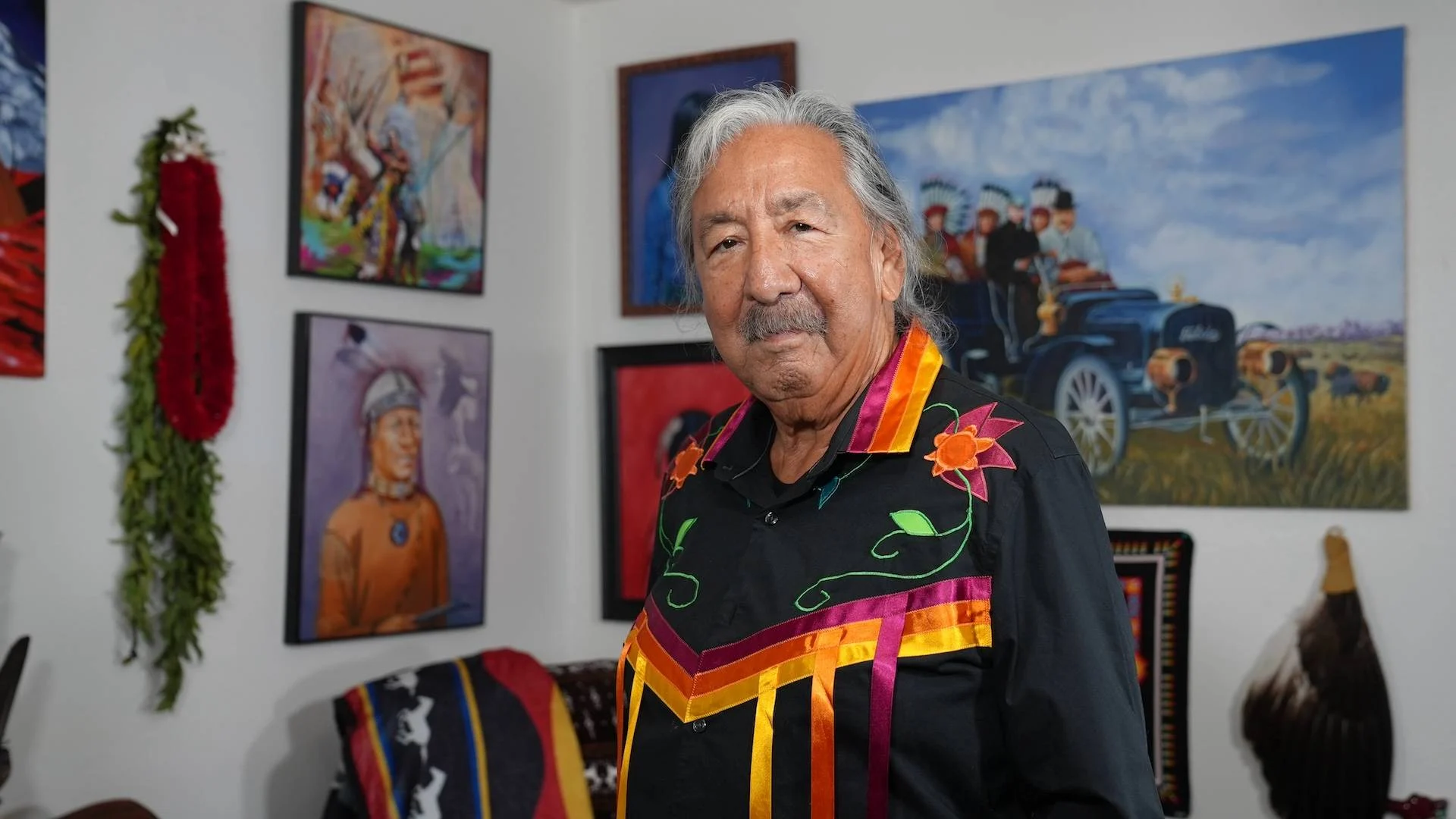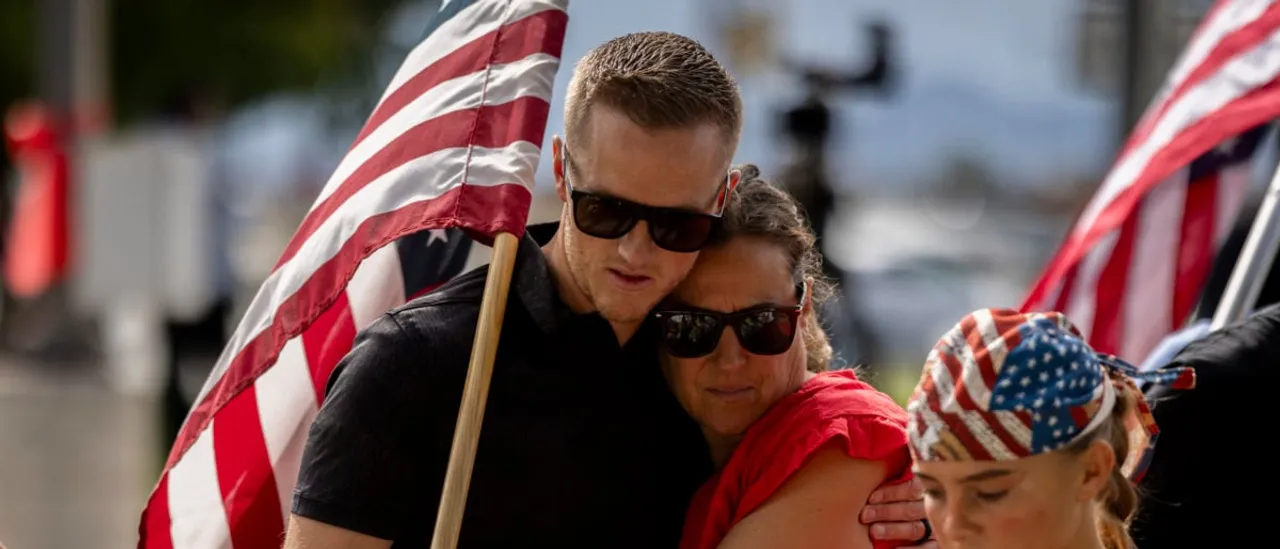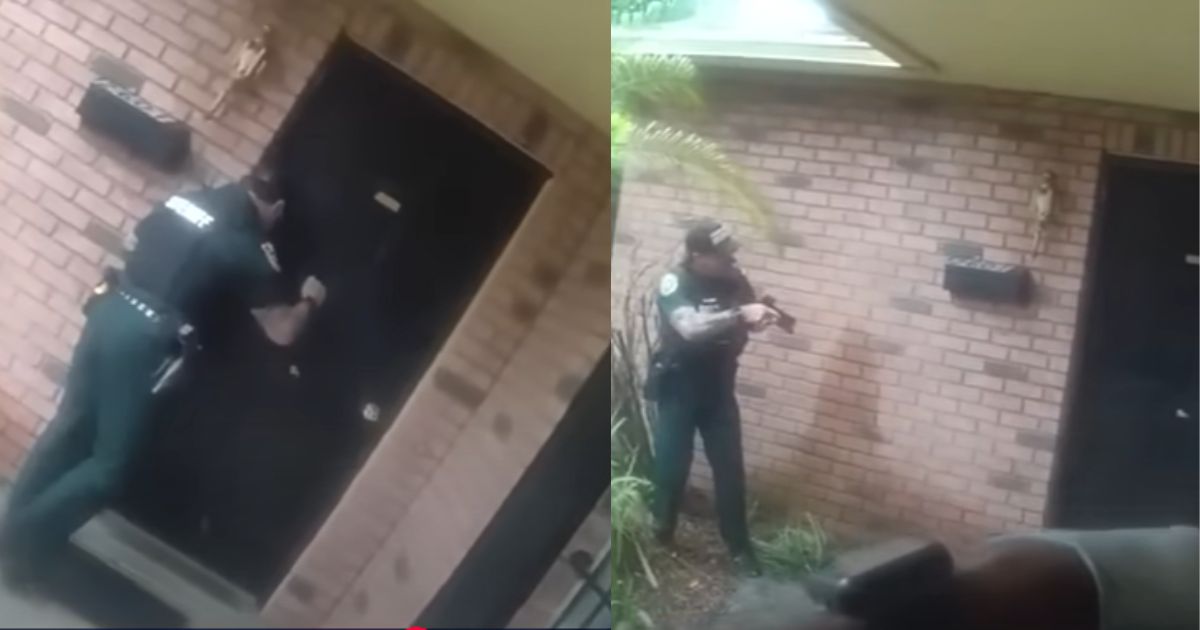By Amy Goodman
Copyright truthout

AMY GOODMAN: So, take us back in time. Introduce us to you, starting by saying your name, who your parents were, the nations they were a part of, your family, where you lived growing up.
LEONARD PELTIER: OK. My name is — English name is Leonard Peltier. I’m 81 years old as of yesterday. My father is a Chippewa Cree, from this reservation, this nation right here.
I keep saying “reservations,” because we was trained — we was taught from childhood that we are all reservations, we’re Indians. And we’re not Indians, and this is not a reservation. We made treaties with the United States government, and the Constitution says they shall only make treaties with sovereign nations. So we’re sovereign nations. We’re not — we’re not Indians, as they claim to be — they claim we are.
And my mother is from Fort Totten. But again, that’s not the real name. The real name is Spirit Lake, and that’s of the Lakota/Dakota people.
I was raised, majority of my life, here with my grandparents, which is usually the traditional way of my people. The grandparents will take the children and raise them. But when grandpa died, grandma had no way, no way to support us, so she went to the agency here to ask for help. And in retaliation, they took us and put us in a boarding school.
AMY GOODMAN: What boarding school?
LEONARD PELTIER: Wahpeton, North Dakota, 1953. I was there ’til — for three years, ’56. And it was extremely brutal conditions.
AMY GOODMAN: How old were you?
LEONARD PELTIER: I was 9 then, when I went. And —
AMY GOODMAN: Talk about the point of these boarding schools. Was your hair cut? Did they stop you from speaking your language?
LEONARD PELTIER: Of course. They did all — they did — that was the purpose of the schools, is to take the Indian out of the Indians, is what they literally — was the order. They took us to the boarding schools. The first thing they did was cut all our — buzz cut our hair, took it all off, and then put us and took us into the shower. We showered, and we come out of the shower, and we were poured all over our bodies DDT. As you know, that’s poisonous.
AMY GOODMAN: They poured DDT over your body?
LEONARD PELTIER: They poured DDT, with all the cans, on your head, the whole body. And then they gave us — issued clothes, bedding and assigned us to a bed. And that was the beginning of our treatment. It was an extremely, extremely strict school, and beatings were regular for any little violation of those rules.
I might have been a little hot-headed, I don’t know. But when I first got there, there was a group. They called themselves the Resisters. And I immediately joined them, and I became part of the Resisters. So, we would sneak behind the gymnasium, and we would talk our language. We would sing some song, even do some prayers, yeah. And if we got caught, we got the [bleep] beat out of us.
AMY GOODMAN: You wrote in your book, Prison Writings: My Life Is My Sun Dance, that you consider these boarding schools your first imprisonment.
LEONARD PELTIER: Yes, it was. Was. I found the rules more restrictive than when I went — ended up in prison.
AMY GOODMAN: So, you go to this residential school with your cousin and sister for three years. Where do you come back to? And how did you maintain your language and your culture?
LEONARD PELTIER: Well, I came back here to live with my father. And they were still living in log cabins, no electricity, no running water. We had to haul water. We had to haul wood. And we only had $55 to live on, which was my father’s World War II military benefits, and that’s what we had to live on.
And we were facing the — we were facing the time of termination. The United States government wrote a bill, passed by Congress, signed by the president, of termination in 1956. It was supposed to be completed by 1985. And the first one to be terminated was the Menominee Indians of Wisconsin. They had millions of making — millions of prime land, timber and lakes to make hunting lodges and other things out there. It was beautiful, which they do today. They still — they got all those things out there today. But they came and took all that land from them. Then they come here in 1958. Was it ’58? Yeah, ’58. I was 13 years old then. And they came and told us we have been terminated, and we have to accept that. We were supposed to be the second reservation to be terminated.
AMY GOODMAN: The Turtle Mountain Band of Chippewa Cree.
LEONARD PELTIER: Turtle Mountain Band of Chippewa Cree, yes. And my father and all of them and their generation, a lot of people left on relocation. They said, “It’s hopeless. We can’t fight these people. They’re too powerful. They got — they’re just too powerful. You know, maybe life will be better over there,” and stuff like this on this relocation. So they picked the city to go to. A lot of them went to Washington state and Oregon.
And it was a small group of us stayed here and said, “No, we’re not leaving.” So, my dad and his generation said, “Well, what do you mean, ‘been terminated’? You can’t come here and tell us that we got to leave and you’re going to just terminate us as a race of people and tell us that we no longer exist. Go [bleep] yourself. Come on. Let’s fight it out.” And literally, they were — I was proud of them. I was 13 years old.
They stopped all provisions. One little girl died over here from malnutrition, and that’s what really got everybody angry.
AMY GOODMAN: So they thought they would starve you out.
LEONARD PELTIER: Yeah, they were making conditions so hard that we were accepting termination. We were leaving. A lot of people took to say, “Well, at least my kids won’t starve to death.”
AMY GOODMAN: And the BIA reversed its decision?
LEONARD PELTIER: They reversed their decision and gave us $50 —
AMY GOODMAN: Vouchers?
LEONARD PELTIER: Vouchers to go buy groceries here in Rolla. Everybody got — the whole reservation got $50.
AMY GOODMAN: And they didn’t disband the reservation?
LEONARD PELTIER: No, they got the hell out of here, because we told them we’re going to fight them.
AMY GOODMAN: So, this was really the beginning of the Red Power Movement and the founding of AIM, right?
LEONARD PELTIER: Well, I guess so, in so many — yeah, in so many — yeah.
AMY GOODMAN: The American Indian Movement.
LEONARD PELTIER: Yeah.
AMY GOODMAN: Which you want to rename the American —
LEONARD PELTIER: But they were — but they were doing that for — I mean, my people have been fighting back for 500 years, Amy.
AMY GOODMAN: But the modern day.
LEONARD PELTIER: Yeah, the modern-day stuff. But no, we went to war with them. We went to all kinds of different levels of —
AMY GOODMAN: Resistance?
LEONARD PELTIER: Resistance, you know.
AMY GOODMAN: So, talk about the founding of AIM, the American Indian Movement, which you today would like to rename the American Indigenous Movement.
LEONARD PELTIER: Well, I was involved in a number of different organizations before I joined AIM. And one of the biggest ones that I was — I helped organize the United Tribes of All Indians in Washington state. And we took over Fort Lawton. One of the treaties that we were pushing them days — actually, our people was — older people were pushing this, too, but they just passed. All of our knowledge came from traditionalists. That’s the policies, the American Indian Movement, we followed there. There.
First of all, people got to understand, the American Indian Movement policy is they can’t come onto this reservation, start dictating their policy. They have to be invited by the traditionalists or a tribal government or what else. We can’t just go onto a reservation and say, “You’re going to do this, you’re going to do that.” No, we can’t do that, and we don’t do that. We have to be invited first.
So, anyway, this was before I joined the American Indian Movement. I was involved with the fishing and hunting struggles over there. That was a big area that they really fought hard and got really —
AMY GOODMAN: Fishing and hunting rights.
LEONARD PELTIER: Yes, treaty rights. In fact, Marlon Brando got arrested with us in 1955. He got arrested on one of them lakes. I wasn’t there, but he was — he got arrested fishing and hunting with the Natives out there.
AMY GOODMAN: So, talk about the occupation of the BIA offices in Washington, moving on to Wounded Knee and Pine Ridge.
LEONARD PELTIER: Well, it just — our resistance became extremely popular. American Indian Movement was growing, and not just here in America — Canada, Central America. Said, “Wow! There are a lot of full bloods all through Central America,” more than people — more than here in the United States. And we were uniting with all of them, all those Natives across this country — across this whole continent, I mean. And we were uniting. We were pulling them together with the American Indian Movement. That’s why we became a threat to the government so.
And later, later on, when I was arrested — after I got arrested, this one guy was telling me, he said, “You know, it just went down to Mexico someplace, one of them towns.” And he said they were organizing for resistance and stuff like this. He said, “I was down there, down there visiting them.” He said, “I went to this old — this guy told me he was the — he was some kind of medicine man or something. So I went down and visited him, and so I went into his place,” into his — he had kind of a hut-like home, I guess. And he said, “What do I see?” He said, “I see your poster on one of the walls.” That’s so far back. But I wasn’t. We went through all that stuff. And so, anyway —
AMY GOODMAN: But especially for young people to understand, I mean, you’re talking about this critical moment of 1973, ’4 and ’5.
LEONARD PELTIER: ’60s, actually.
AMY GOODMAN: What’s that?
LEONARD PELTIER: Started in the ’60s, really.
AMY GOODMAN: And also the height of the antiwar movement. And the role and the effect of the antiwar movement on the Native American movement, and vice versa? If you can talk about those critical moments?
LEONARD PELTIER: We were — I was, and others were, a lot of us Natives were — we were also involved in the peace marches and with the Blacks and the antiwar movements and things like that. We were involved in all that stuff, too. But we were working on trying to get their support, and they were working on trying to get our support. Then the hippies came out, and the hippies really helped us. The hippies did a lot to help us. They started dressing like Natives. They started doing things like Native people. And a lot of them came from very, very wealthy families. A lot of people hated them. That’s one of the reasons the government hated them, is because they were really pushing the Native issues, the culture and stuff like that.
AMY GOODMAN: So, the Trail of Broken Treaties, that was 1972. Explain what it was, which was a takeoff on the Trail of —
LEONARD PELTIER: Well, we knew that we had to get to — get the government to start honoring our treaties, because they never honored our treaties. And the only way we could do this is to go right straight to Washington. And so, we organized a group. We called it the Trail of Broken Treaties. And we all organized from all over the country. They sent representatives in old cars. We had all — nobody had new cars them days. And we all went to Washington.
AMY GOODMAN: You went?
LEONARD PELTIER: Of course, I did. Of course, I was there, too, yeah.
AMY GOODMAN: This is, of course, a takeoff on the Trail of Tears. And most people, in our schools, and maybe less so especially now, will ever even know what the Trail of Tears was.
LEONARD PELTIER: Right, right, right, precisely. That was all past — everything we did, we called it — well, like the Trail of Broken Treaties, that was done out of the Trail of Tears, and the Long Walk, all them other events like that that happened. It wasn’t just the Trail of Tears. That’s what people have to understand. It was — the Trail of Tears was just one of them that became so well known, because I think 10,000 people died on that, and just laying alongside the trails and stuff from dying from sickness, malnutrition, all that stuff, on the Trail of Tears. And that’s why it got so —
AMY GOODMAN: This was President Andrew Jackson?
LEONARD PELTIER: Yes, yeah.
AMY GOODMAN: The president who President Trump reveres.
LEONARD PELTIER: It was [bleep] order, yeah. He was a anti — he was a hater. And so, we were — we [inaudible], we organized. We organized under basically the same policies of exposing what was done in the past, what continued to be done.
And we still find it’s still happening today, Amy. Ann Coulter had made a public statement that — about Native people, that we didn’t kill enough of them Indians. That’s a very dangerous thing to say about anybody, because there’s a bunch of nuts out there, like, you know, you take one of them haters and everything, he can end up killing a lot of innocent Natives for — just because those type of words.
You got a president trying to do away with our treaties. If our treaties go, we go. This is the only thing to prove that we are a sovereign nation and a race of people. And if that goes, we go, as a race of people. So, it’s not — I mean, it’s not ending for us. We’re still in danger. Yeah, you see it happening in the streets, you know, I mean, right today. Look at what they’re doing in Palestine, killing women, children, babies, unborn babies. That’s what they did to us, man. And here it is still happening.
AMY GOODMAN: So, 52 years ago, 1973, the start of the American Indian Movement’s 71-day occupation of the village of Wounded Knee on Pine Ridge Reservation, occupation helping draw international attention to the plight of Native Americans, the U.S. government responding to the occupation with a full military siege that included armored personnel carriers, F-4 Phantom jets, U.S. Marshals, FBI, state and local enforcement. During the occupation, two Sioux men shot dead by federal agents, and a Black civil rights activist, Ray Robinson, went missing. The FBI confirmed in 2014, decades later, that Ray Robinson had been killed during the standoff. Most people don’t know about this history.
LEONARD PELTIER: No.
AMY GOODMAN: Maybe they’ve heard the book Bury My Heart at Wounded Knee. So, can you talk about Pine Ridge and Wounded Knee, especially for young people who don’t know the history?
LEONARD PELTIER: Well, I was in jail during the beginning of Wounded Knee, but I got out. It was about halfway through. Then I went, and I went up there, and I helped pack in stuff into Wounded Knee. And I stayed out there on the outside forces.
After we made all those trips to Washington and all that stuff, all those other demonstrations, and all those promises, they were going to do this and do that. They were going to investigate everything, all of our acquisitions and all that stuff. And we soon found out — we knew anyway, but we soon found out that was all a lie. They weren’t going to investigate [bleep]. And they didn’t.
And so, finally, the elders and the chiefs made the decision to go to Wounded Knee. AIM had no part in that decision. We cannot go anyplace in Indian Country and make policies. We can’t. That’s not — that is not us. We can’t do that. And we can’t go unless we’re invited by those people. And they just got fed up with so many more false promises and what was happening.
They were being terrorized by a group organized by — a mercenary group, I might add. They were provided with intelligence, armored person ammunition, sophisticated weapons, surveillance and stuff like this, automobiles and stuff. And the leader made that — admitted that on a national interview. So we know that’s all true. They tried to deny it at first, but they called themselves the Guardians of the Oglala Nation. And —
AMY GOODMAN: The GOONs.
LEONARD PELTIER: The GOONs, yeah.
AMY GOODMAN: Dick Wilson’s.
LEONARD PELTIER: Dick Wilson, all them. Nixon ordered the 82nd Airborne to go and investigate what’s going on down there. And if there was — if we were like the government was claiming, that we were communists and Marxists, and we were being financed by the communists, they were to go up there and wipe us out.
When Nixon got the 82nd Airborne involved in it, we filed a lawsuit. And it took us 10 years, but we got all this information out of the files that they had to turn over to us, right? And we found that they had went to the armory and checked out 250,000 rounds of various caliber ammunition, different sophisticated weaponry, armored personnel carriers, and finances and surveillance and stuff like that. See, that was all illegal. And that’s how we found out a lot of stuff about what they were doing there. And it was all illegal. If it would have been left to Nixon, he would have — he was going to wipe us out. But he didn’t, because, we heard, his wife stepped forward and said, “No, don’t you do that.”
AMY GOODMAN: Now, still going back 50 years, what landed you in jail? I want to go to the words in Democracy Now! in 2003. The occupation of Wounded Knee is considered the beginning of what Oglala people refer to as the Reign of Terror, from ’73 to ’76, over 60 residents killed in this period. Murders went uninvestigated by the FBI, which had jurisdiction. The period culminating in the June 26th shootout for which Leonard Peltier was imprisoned.
LEONARD PELTIER: First of all, I don’t know who the shooter is, or shooters. And I don’t — I wouldn’t tell you if I did know, so I’m not going to tell you anything in that area. But I’ll tell you — I’ll speak on the other issues, because it’s public knowledge, and it’s been — it’s been our attempts to continue to expose that stuff.
But there was a lot of Native people, traditionalists, whose homes were burned, whose houses were — was drive-by shootings. People were pulled over and beaten, and some shot, some killed. And those things are literally recordings on this. We got records of all this stuff now, so people can’t deny this stuff. The only ones that are denying this [bleep] is the United States government and the FBI and people like that.
But we faced a time called the Reign of Terror, when they were getting away with all this [bleep]. None of them were getting investigated. A lot of the older people that seen these people identified them, but the FBI still wouldn’t investigate. They were able to kill people at random. They were — and getting away with it, because they didn’t have — they had no fear of being prosecuted. The only fear they had was of us, the American Indian Movement, because we wouldn’t take their [bleep]. Every chance we got together, we got a confrontation with them. And that’s the only fear they had of anything, of any retaliations, any arrests or anything else.



